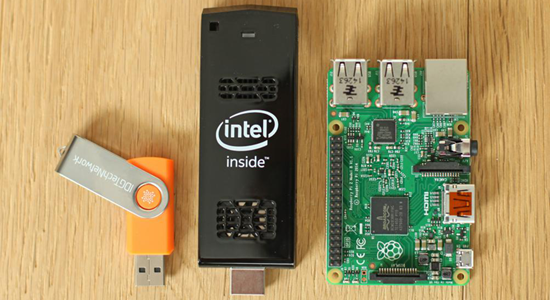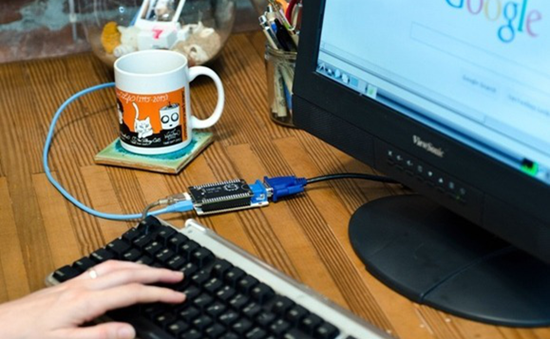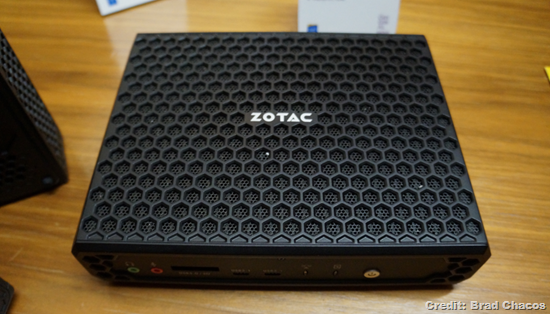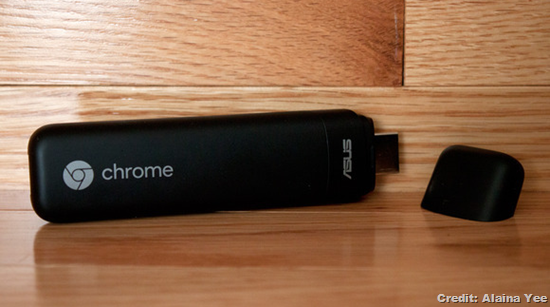
Mini PC invasion: These radically tiny computers fit in the palm of your hand
By Brad Chacos, PC World, 21 January 2016.
By Brad Chacos, PC World, 21 January 2016.
Some of today’s desktops can make even the sleekest of laptops seem downright bulky.
Computers have been shrinking for years, and the revolution has only accelerated in recent times. As chip-makers focus on creating processors that sip power without sacrificing performance, thermal concerns have largely been alleviated in modern CPUs. Because of that, today’s pint-sized PCs offer enough performance to play HD video and satisfy Office jockeys, the opposite of the janky, compromised experience of yesteryear’s microcomputers.
From PCs-on-a-stick to discreet boxes no larger than a deck of cards, let’s take a look at the wide range of computers available that can fit in the palm of your hand - starting with the one that embedded teeny-tiny PCs in the public eye.
Editor’s note: This article originally published on April 17, 2015 but has been updated as new models and information became available.
1. Raspberry Pi
The Raspberry Pi receives accolades for kicking off the maker revolution, but it also thrust the idea of tiny computers into the limelight. The Pi certainly doesn’t look like a traditional PC: It’s an open board powered by components usually found in smartphones, not computers, and it even draws power via a Micro-USB connection - just like mobile devices.
Don’t let that fool you though. The Raspberry Pi is a real computer with real (albeit lightweight) computing chops. It can run several varieties of Linux, and the Broadcom VideoCore IV GPU is powerful enough to output 1080p video without a hitch, making this US$35 mini-PC a viable home theatre PC option. (Pro tip: Use OpenELEC.) Best of all, the Raspberry Pi 2 runs circles around the original while sticking to the same US$35 price point.
The Raspberry Pi Foundation recently released an official touchscreen accessory for the Pi, which should help makers create all sorts of eye-opening projects. The BBC Micro:bit is following in the Raspberry Pi’s education-focused footsteps, with the BBC giving the programming board to Year Seven school children in the U.K starting this October - though it can’t be used as a standalone computer.
2. Chip
Can’t spare US$35 for a Raspberry Pi 2? Meet Chip, an even smaller, even more modest PC that costs a mere US$9. It’s powered by an ARM-based processor from Allwinner, a low-cost producer of chips for smartphones and tablets, and a Raspbian-like Linux-based operating system pre-installed.
Measuring a mere 2.3-by-1.5-inches, Chip comes with 1GHz Allwinner R8 Cortex A8 processor with Mali-400 graphics, 512MB RAM, 4GB storage, and built-in Bluetooth and Wi-Fi. Compared to the Raspberry Pi 2, Chip’s processor - which is similar to the Allwinner chip in the US$100 HP 7 G2 Android tablet - should be woefully slow, but its baked-in storage and wireless connectivity is something that Pi simply doesn’t match.
Now for the bad news: Chip isn’t publicly available yet. It blew past goals in its crowd-funding campaign and started shipping to backers around New Year’s, but if you order Chip today it won’t show up at your doorstep until June 2016.
3. Raspberry Pi Zero
But mini-PCs come even cheaper. In November, the Raspberry Pi Foundation revealed the Raspberry Pi Zero, a US$5 version of the iconic computer that still runs 40 percent faster than the original despite its low, low price. That’s so cheap that it was bundled for free with MagPi magazine in the U.K. to herald its launch.
The Raspberry Pi Zero rocks the same Broadcom BCM2835 application processor as RP1, with a 1GHz ARM11 core. It’s packing 512MB of RAM and a microSD card slot for the operating system, while it talks to the outside world via mini-HDMI, micro-USB ports, and 40 GPIO pins (you know, for crazily innovative maker projects).
4. Intel NUCs
On the other side of the puny PC coin is Intel’s Next Unit of Computing, a polished, premium product that delivers full-blown desktop performance - albeit for a price often 10-times higher (or more) than the Raspberry Pi’s cost.
NUCs use full-blown Intel Core processors inside their seriously sleek cases, which gives them abundant bite when it comes to computing. Actual performance metrics vary, however, depending on how you outfit your rig. Intel’s NUCs - and its Gigabyte Brix cousins - are bare-bones PCs, meaning you’ll have to bring your own storage, memory, and operating system to the party.
Make no mistake: All told, you pay a premium for Intel’s NUC. But damn if it isn’t nice - and Intel’s whipping up a powerful “Skull Canyon” NUC variant that packs a quad-core Skylake processor and the company’s high-end Iris Pro graphics.
5. Asus Chromebox
What, pricey Windows machines aren’t your thing? Check out the Asus Chromebox, the desktop equivalent of a Chromebook. At 4.88-by-4.88by-1.65 inches, it’s slightly larger than the NUCs and Brixes of the world, but still svelte enough to fit in your hand.
Don’t scoff about Chrome OS, either. Google’s operating system is surprisingly potent despite lacking compatibility with Windows software - and at US$160 for the base model, the price of the Asus Chromebox is certainly right.
6. HP Stream Mini PC
If the Chromebox’s lack of software support trips you up, fear not: HP’s Stream Mini PC starts at just US$250 and runs the full-blown version of Windows 10.
This is a tempting little box at that price, but be aware: You still won’t be able to run ultra-demanding programs very well on the Stream Mini PC, because it only packs a modest Intel Celeron 3205U processor, 2GB of memory, and a 32GB M.2 SSD. Plus, at 5.71-by-5.71-by-2.13 inches, it’s the largest tiny computer in this roundup. It'd still work great for a basic productivity and web-browsing machine, though.
7. Zotac's legion of little PCs
Zotac’s been making mini-PCs since before mini-PCs were cool with the iconic Zbox bare-bone PC line-up, and it offers a staggering array of itty-bitty computers for everything from basic word processing all the way up to gaming and 4K video playback. We went eyes-on with Zotac’s mini-PC horde at CES; check them out!
As part of the new announcements at the show, Zotac announced a new Intel “Cherry Trail” Atom-based “PC Stick” that crams an entire computer onto a flash drive-esque stick that plugs into any TV or monitor. That’s a hot new trend in computing, spurred on by…
8. Intel Compute Stick
You’d be hard-pressed to find a desktop PC much smaller than the Raspberry Pi or Zotac’s Zbox Pico. But forget traditional desktops! Advances in technology have shrunk computers so much that they’re now available in Chromecast-like stick form. Just plug it into your display’s HDMI port, connect to USB for power, and you’re ready to rock - though you’ll obviously need a (preferably Bluetooth) keyboard and mouse as well.
Intel’s US$150 Compute Stick is a PC-on-a-stick generating a ton of excitement, and it’s easy to see why with that form factor. Our original Compute Stick review found it neat, but niche. At CES 2016, Intel announced a new Compute Stick lineup powered by more potent Core M processors, but at less friendly prices - they start at US$400. An affordable entry-level Compute Stick will stick around, though, rocking an Atom x5-Z8300 CPU, 32GB of storage, 2GB of RAM, 802.11ac Wi-Fi, two USB ports, and Windows 10 for US$160.
9. Attack of the clones
Intel’s Compute stick kicked off a wave of clones, with most of sporting the same basic internal hardware configurations, though some are fancier than others. The Archos PC Stick, for example, is the cheapest Windows-on-a-stick device we’ve seen yet, with a mere US$99 asking price. Lenovo and BeeLink also offer branded Compute Stick pocket PCs of their own.
The most notable Compute Stick-like device announced thus far, however, may be the Asus Vivo Stick (pictured). While many of the other available Windows stick PCs run on Intel’s older Bay Trail chips, the Vivo Stick packs Intel’s fresh Cherry Trail processor, as well as Windows 10 and an extra USB port for peripherals. Even better, it’s only US$130 - US$20 less than Intel’s original Windows-based Compute Stick.
10. Asus Chromebit
But forget about Windows! Asus’ Chromebit is almost more exciting, largely mirroring the spec sheet of the Compute Stick legion (aside from a Rockchip processor) but featuring Google’s Chrome OS instead.
As Alaina Yee said in PCWorld’s review of the Chromebit: “Unlike Intel’s Compute Stick or even other Chrome OS machines, the Chromebit is actually an easier sell to a wider variety of people. It’s not necessarily a replacement for a streaming box or a full Windows PC. Instead, it’s a nice complement to the overall ecosystem of gadgets you may already own.”
There’s just one caveat to be aware of: The Chromebit only has a single micro-USB port for a hardwired peripheral, so you won’t be able to plug both a keyboard and a mouse into it. But the pint-sized PC supports Bluetooth for wireless devices.
11. Android-on-a-stick
Stick-based computing is nothing new in the world of Android, however. I reviewed Rikomagic’s Android 4.0-based MK802 II micro PC more than two years ago, and the market has only expanded since then. There are a slew of Android-PC-on-a-stick devices available today, sporting the same basic design principles as Intel’s Compute Stick and all costing far less than US$100.
Given the HDMI-centric design of these devices and the Play Store’s vast entertainment app library, Android sticks can excel as basic home theatre PCs, adding streaming capabilities to televisions that lack Internet connectivity.
12. Acer Revo Build
The Revo Build’s “base” is a mere 4.9 inches square, packing either a Celeron or Pentium processor from Intel and up to 8GB of memory. If you need more computing capability, you add it by simply stacking optional modules atop the base, with magnetically aligned connectors making it easy. Hot-swappable 500GB/1TB hard drive modules will be available, while a wireless charging and an “audio block” with integrated speakers and a mic will be gradually rolled out over time, all for prices unknown.
13. Mintbox Mini
The sleek Mintbox Mini squeaks in at just 0.95 inch tall and is a whopping five times smaller than the original Mintbox mini PC. This computer’s distinctive not only for its tiny size, but also because it runs Linux Mint out of the box. With an AMD A4 6400T processor packing Radeon R3 graphics, 4GB of RAM, and 64GB of solid state storage, the Mintbox Mini should be able to handle basic web browsing, video playback, and productivity suite tasks just fine.
Even better? Between the SSD and the passive cooling for the processor, this pint-sized PC runs utterly silently.
14. Your phone
Finally, today’s modern smartphones have more in common with an ultra-portable computer than the landlines of old. The mature app ecosystems of both the App Store and the Play Store are more than capable of handling your basic computing needs, from productivity to entertainment to web browsing. No joke.
With a dock and some external peripherals, you can even turn your phone into a basic desktop PC for cheap - though it can take some time to get accustomed to navigating a touch-centric interface with a keyboard and mouse. If you decide to give it a whirl, PC World’s guide to 13 highly productive Android apps that play nice with your PC can help you integrate your phone with your general computing lifestyle.
Top image credit: Gordon Mah Ung.














No comments:
Post a Comment
Please adhere to proper blog etiquette when posting your comments. This blog owner will exercise his absolution discretion in allowing or rejecting any comments that are deemed seditious, defamatory, libelous, racist, vulgar, insulting, and other remarks that exhibit similar characteristics. If you insist on using anonymous comments, please write your name or other IDs at the end of your message.